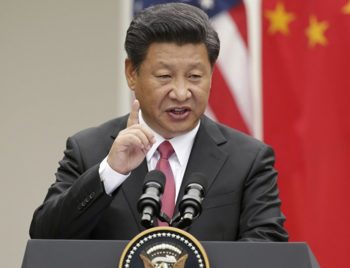
China has increased tariffs by up to 25 percent on 128 U.S. products, from frozen pork and wine to certain fruits and nuts, escalating a dispute between the world’s biggest economies in response to U.S. duties on imports of aluminum and steel.
The tariffs, which came into effect on Monday, were announced late on Sunday by China’s finance ministry and matched a list of possible tariffs on up to $3 billion in U.S. goods published by China on March 23.
Soon after the announcement, an editorial in the widely read Global Times newspaper warned that if the United States had thought China would not retaliate or would only take symbolic counter-measures, it could “say goodbye to that delusion.”
“Even though China and the U.S. have not publicly said they are in a trade war, the sparks of such a war have already started to fly,” the newspaper said.
The Ministry of Commerce said it was suspending its obligations to the World Trade Organization (WTO) to reduce tariffs on 120 U.S. goods, including fruit and ethanol. The tariffs on those products will be raised by an extra 15 percent.
Eight other products, including pork and scrap aluminum, would now be subject to additional tariffs of 25 percent, it said, with the measures effective from April 2.
“China’s suspension of its tariff concessions is a legitimate action adopted under WTO rules to safeguard China’s interests,” the finance ministry said.
China is moving swiftly with retaliatory action amid escalating trade tension with the United States, which has rocked global financial markets in the past week as investors fear a full-blown trade dispute between them will damage world growth.
U.S. President Donald Trump is separately preparing to impose tariffs of more than $50 billion on Chinese goods following an investigation under Section 301 of the 1974 U.S. Trade Act.
The U.S. administration says China has systematically misappropriated American intellectual property – allegations China denies.
About the Section 301 investigation, China had “yet to unsheathe its sword,” the official Xinhua news agency said.
Sometime this week, the Trump administration is expected to unveil a list of Chinese goods that could be subjected to new U.S. tariffs.
U.S. technology industry officials said they expected the list to target products that benefit from Beijing’s “Made in China 2025” program, which aims to upgrade the domestic manufacturing base with more advanced products.
China has repeatedly promised to open its economy further, but many foreign companies complain of unfair treatment. China warned the United States on Thursday not to open a Pandora’s Box and spark a flurry of protectionist practices across the globe.
“There are some people in the West who think that China looks tough for the sake of a domestic audience, and would easily make concessions,” the Global Times said. “But they are wrong.”
The Global Times is run by the ruling Communist Party’s official People’s Daily, although its stance does not necessarily reflect government policy.
Reaction to China’s measures varied on social media, with some saying Chinese customers would be the ones to ultimately pay for a trade war.
“Why not directly target soybean and planes? The tariffs that China announced today don’t sound a lot to me,” said a user on the Weibo microblog platform.
Aircraft and soybeans were China’s biggest U.S. imports by value last year.
In a statement published on Monday morning, the commerce ministry said the United States had “seriously violated” the principles of non-discrimination enshrined in World Trade Organization rules, and had also damaged China’s interests.
“China’s suspension of some of its obligations to the United States is its legitimate right as a member of the World Trade Organization,” it said, adding that differences should be resolved through negotiation.
Weibo prominently featured the list of U.S. goods that China is targeting among the day’s “hot” trending topics.
“I will never buy fruit from the U.S.,” a Weibo user wrote.
Source: Bloomberg